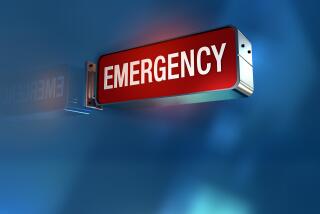One tiny cut, one big obligation
My patient’s laceration was relatively easy to suture. Only one layer of stitches would be needed, and I could have him on his way in less than 20 minutes. My years working in the emergency room had made me comfortable with minor injuries; the repair looked good, and the scarring would probably be minimal.
I had just come back from maternity leave, and it was nice to be back in the saddle, working at my craft once again. I cleaned and dressed my patient’s wound, gave him a tetanus booster, then shook his hand and asked him to return in two to three days for a follow-up to check the healing.
My next patient was waiting, so I quickly gathered the drapes, leftover suture, needles, forceps and other detritus in the exam room to move them to the biohazard bin near the sink. I paid careful attention to avoid contaminating patient areas with blood-borne pathogens such as HIV and hepatitis B and C. Infected blood could transmit the viruses to another patient through mucous membranes or cut skin.
As I picked up the bundle of materials, I heard a clatter and felt a pinch on the top of my foot. I looked down and saw that the sharp scissors I had used to trim the edge of my patient’s laceration had bounced off a bare patch on my foot just beyond the edge of my closed-toe shoe.
My initial reaction was irritation. I placed the rest of my package in the cleanup area and came back and picked up the scissors.
I noted -- now with alarm -- that the tips were stained by moist blood. A glance at my foot showed a small amount of bleeding at the puncture site. It was clear that most of the blood on the scissors had been my patient’s. There was a small chance that, as they broke my skin, the blades could have infected me with a virus that could cause hepatitis or AIDS.
There were patient charts stacking up in my in-box. I tried to downplay the incident to myself. After all, I had completed my series of hepatitis B vaccinations, my patient was unlikely to have one of these viruses, the almost-dried blood on the scissors was probably no longer contagious, the exposure on my foot was too shallow and too limited to truly be a risk, my own bleeding would wash out any possible contaminants. . . .
Shrugging my shoulders, I intended to continue with my schedule as if nothing had happened. Until the next instant, when I remembered that I was breast-feeding. Any blood-borne infection I might conceivably catch would put not only me but also my baby son at risk. The virus could then be passed on to my child through my breast milk.
Additionally, if I were to get HIV or hepatitis C, God forbid, it would be critical to be aware of my health status and to take precautions to avoid the low risk of passing on the infection to my family -- or patients.
I laid down my charts with a sigh. There was no other choice: I would have to report the incident and get a risk assessment and an infection evaluation -- and my patient would have to get one too. I would also have to, hopefully temporarily, pause breast-feeding until I could be sure that I was not infected and that I didn’t need preventive treatment with the antiviral agent AZT.
A recent study in the New England Journal of Medicine reported that more than 80% of surgeons in training had had needle-stick injuries, more than half of which involved patients at high risk of being infected with HIV or a hepatitis virus. However, 51% of these incidents -- 16% involving high-risk patients -- were not reported.
The reason most often given -- lack of time -- was certainly a concern for me. But embarrassment, denial and the often underestimated perception of a patient’s risk were also significant excuses -- and ones that had crossed my mind as well.
Asking a colleague to fill in until I returned to my clinic, I rushed to our employee health facility and began the evaluation and laboratory tests needed to establish my baseline status regarding HIV and hepatitis. We also contacted my patient and asked him to come in for screening tests that could determine if he was infected with blood-borne pathogens.
He was understandably annoyed at the inconvenience but cooperative. To my relief, he provided us with information about his personal and medical history that indicated he was not likely to have been exposed or infected by hepatitis or HIV.
Aware that patient reports may not always be accurate, I weighed the pros and cons of post-exposure prophylaxis (preventive treatment) with AZT and finally opted not to begin the antiviral medicine.
However, until the confirmatory laboratory tests came back a couple of days later, I did use breast milk for my son that I had pumped and frozen before my injury. To my relief, the tests showed that my patient was not infected with these pathogens. -- as did my own lab results over the ensuing weeks.
I was grateful for the reassuring outcome -- but my scenario is repeated in examination and procedure rooms, operating suites and other healthcare sites every day, often in riskier situations and, sometimes, sadly, with less fortunate results.
At our center, doctors and nurses who are injured by needles or other bloody objects are required to go to an occupational health provider that offers supportive evaluations and preventive treatment. We also provide regular educational programs that stress the importance of precautions to prevent injury and describe the necessary steps to reduce risk in case of a mishap.
Educating health professionals about the importance of reporting potentially infectious injuries should be part of the baseline of healthcare.
Accidents happen, and reporting the incident, getting an evaluation and, if appropriate, taking post-exposure preventive treatment, are actions we not only owe to ourselves but also to our patients.
--
Dr. Linda Reid Chassiakos is director of the Klotz Student Health Center at Cal State Northridge and a clinical assistant professor of pediatrics at UCLA.
If you work in the health/ medical field and have a story to tell or point of view to share about your work, e-mail your submission (750 words or fewer) to [email protected].


